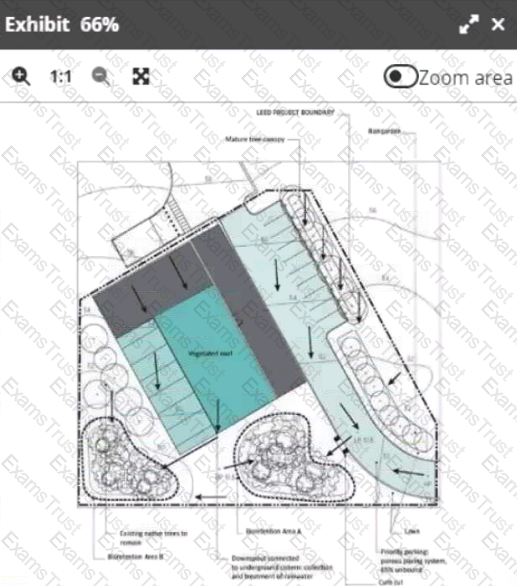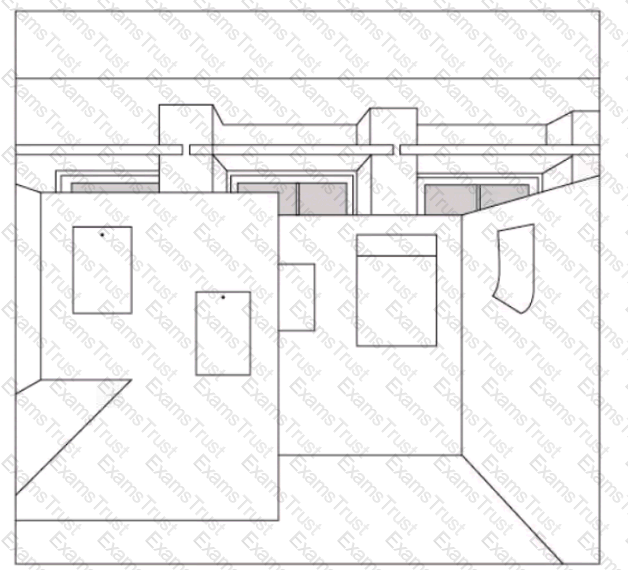Which of the followings operational elements need to be tracked only once during the performance period in order to meet the Sustainable Sites, Site Management Credit?
A standard reference when creating an indoor air quality management program is
Which of the following are required to comply with Energy and Atmosphere Credit, Existing Building Commissioning- Implementation?
The measures called out on the following site plan may contribute to the achievement of which LEED credits?
(Click on Exhibit)
Exhibit

What information is required when adding a new space within a facility to the ENERGY STAR® Portfolio Manager?
The LEED AP has identified a pilot credit that is relevant to the project. This would be documented in LEED Online as a(n)
At what point is it appropriate for the LEED AP to administer an alternative transportation survey to those that visit the building?
Presuming all water fixtures meet the LEED Operations and Maintenance Rating System requirements, which of
the following statements is correct when considering baseline water usage in relation to water use?
Which strategies allow the project to achieve maximum points under Location and Transportation Credit, Alternative Transportation?
Which of the following strategies reduces the impact of materials used in building operation and maintenance on indoor air quality?
Under Indoor Environmental Quality Credit, Interior Lighting, outlet powered task lighting contributes towards
compliance for what category of building space?
What is the diversion percentage of ongoing consumables in order to achieve exemplary performance as specified in Materials and Resources Credit, Solid Waste Management - Ongoing?
Which of the following is a result of a low impact development rainwater management program?
Which of the following alternative transportation strategies help reduce pollution and land development effects from automobile use?
One tenant occupying 50% of a commercial office building pursuing LEED® O+M certification has provided purchasing data. The other tenants in the building occupying the remaining 50% have chosen not to provide purchasing data. For credits related to purchasing, the LEED applicant must
An individual tenant in a multi-tenant building is unwilling or unable to provide their purchasing data. How does this affect the overall requirement for Materials and Resources Credit, Purchasing - Ongoing?
Using the following table, the number of cooling tower cycles in Water Efficiency Credit, Cooling Tower Water Use is determined by which five parameters in the rating system?(Click on Exhibit)
The compliant value of green cleaning products and materials is calculated using what factor?
What must the project team do regardless of building type for Energy and Atmosphere Prerequisite, Minimum Energy Performance?
Which of the following parameters need to be continuously monitored for occupied spaces in order to qualify for Indoor Environmental Quality Credit, Thermal Comfort?
At a minimum, which two factors must be continuously monitored by the system in order to achieveIndoor Environmental Quality Credit, Thermal Comfort?
Which of the following strategies satisfy the Sustainable Sites Credit, Rainwater Management?\
A manufacturing plant is increasing units produced and the number of employees annually. The building is documenting compliance with Energy and Atmosphere Prerequisite, Minimum Energy Performance, Case 2, Option 1. Path 2 Benchmark Against Typical Buildings Using Comparables. Which of the following should be used to normalize the building's energy use?
A building owner wishes to provide better Indoor Environmental Quality to the building occupants while containing capital costs. The LEED AP suggests pursuing Indoor Environmental Quality Credit, Enhanced Indoor Air Quality Strategies, Option 2. Filtration. However, the existing HVAC system was not designed to accommodate the required filters but is otherwise efficient and operating well. Which strategy would enable credit achievement?
A LEED project is considering converting 75% of its existing composite roof to a vegetated roof. The project's landscape architect also suggests an open-grid pavement system for 30% of the site paving, and colored concrete for 25% of the site paving. Which of the following factors must be considered when selecting the materials for these strategies?
Which of the following plumbing fixtures apply to the calculations in Water Efficiency Prerequisite Indoor Water Use Reduction?
Cooling tower blowdown is necessary because
Instituting a policy to prevent erosion and sedimentation and restore any eroding soils is a requirement of which credit or prerequisite?
A district energy system provides chilled and hot water to a building on a campus. What equipment must be commissioned to meet the requirements of Energy and Atmosphere Credit, Existing Building Commissioning - Analysis, Option 1. Existing Building Commissioning?
The project team of an existing urban site has 4% total vegetated area and desires to increase the percentage to
equal or be greater than 5%. Which strategy can the team implement to achieve this goal?
The minimum amount of renovation or new construction work required to qualify for Materials and Resources Credit, Purchasing - Facility Maintenance and Renovations is
Which of the following is a low impact development (LID) technique for rainwater management?
What must the project team do in order to maximize the reduction in operational costs with regard to Sustainable Sites Credit, Site Improvement Plan?
A LEED AP Operations and Maintenance project is at the end of the second month of the performance period when the team notices that the water meter readings for one of the two submeters is not being recorded. What advice should the LEED AP give the project team in order to comply with Water Efficiency Credit, Water Metering?
To fulfill the Indoor Environmental Quality Prerequisite, Green Cleaning Policy, cleaning chemicals must be handled in a manner that
When conducting the Indoor Environmental Quality Credit, Occupant Comfort Survey what is the minimum percentage of building occupants that must respond?
Which of the following best meets requirements of Sustainable Sites Credit, Site Development - Protect or Restore Habitat?
Which of the following products qualifies under Materials and Resources Credit, Purchasing - Ongoing?
A building manager changes the sequence of operation for boilers to better match heating demand as a result of an ASHRAE Level 2 analysis. Which of the following is an example of an appropriate topic for training of building operations staff to continue implementation of this change and meet the requirements of Energy and Atmosphere Credit, Existing Building Commissioning - Implementation?
An office building has an average annual occupancy of 75% and 30,000 ft2 (2 787 m2) of completely vacant space.
How many occupants should be entered into Portfolio Manager for the vacant office space?
What type of Credential does the principal participant of a project need to earn in order to achieve one point in the innovation credit?
According to Indoor Environmental Quality Credit, Daylight and Quality Views, what is the view factor in the diagram below?

The development of a five-year plan under Sustainable Sites Credit, Site Improvement Plan contributes to the achievement of
In the calculations for Water Efficiency Prerequisite, Indoor Water Use Reduction, private use refers to lavatory faucets used by which of the following types of occupants?
Which of the following LEED AP Operations and Maintenance Water Efficiency Credits has exemplary performance?
What credit rewards customers who change their normal consumption patterns in response to the varying price of
energy over time?
Which of the following is required when documenting a LEED Pilot Credit?
Presuming all water fixtures meet the LEED Operations and Maintenance Rating System requirements, which of the following statements is correct when considering baseline water usage in relation to water use?
An organization pursuing LEED O+M certification for their headquarters has a renovation policy that includes strict requirements around the selection of building products and requires contractors working in the building to develop a plan for the diversion of waste produced during renovation projects. What must the organization add to their renovation policy to meet the requirements of Materials and Resources Prerequisite, Facility Maintenance and
Renovation Policy?